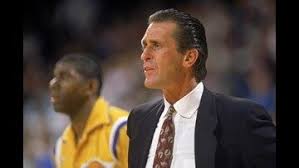[7-minute read]
* “Better Read Than Never”. I’m often late to the party, which prevents me from being a mere trend-follower. (Ha.) I’ve done a bunch of these untimely reviews/appreciations.
Covid-19 made me do it! (Alongside its henchpersons Disorganization, Procrastination and Distraction). You see, I’m in peak spring-cleaning form. Purge Mode. Pat Riley, one of the top leaders in the world of sport, has been leaning handsomely on the front cover of 1993’s The Winner Within in my collection of books on athletics and coaching. I had always passed it by, a bit leery of this seeming attempt to reap business fruits from his basketball story, so it seemed a great candidate for give-away. But here’s where my efforts at Stuff Reduction and Orderliness often go sideways; my thinking, exactly, was this: I can’t get rid of it without reading it first, right? So I did. I read it in a day, and when was the last time I gave myself that little gift? Happy isolation, everybody! And I found that I liked it more than I thought I would. The Winner Within is certainly of its time, it’s no masterpiece of reportage, but it has good stories and a solid underpinning of wisdom. And quotes! (I’m a sucker for books with quotations inspiring, and wisdom marginal.)
As I guessed, Riley’s book does have some tedious business cases and stretchy attempts to relate the Los Angeles Lakers Basketball Club to the boardrooms of America. On the other hand, it is actually well-written (no ghostwriter credited, but Wikipedia says there was one) and damned if I didn’t actually appreciate some of the external stories just as much as I did those of the rise and fall of the Lakers dynasty in its 1980s form. I was an avid consumer of that decade’s emergence of the NBA, as the Boston/LA, Bird/Magic rivalries fueled the rise to the prominence this league enjoys today. Since I viewed those rivalries through glasses with a distinct Celtics-green tinge – call it the Larry Bird Bias – it was interesting to read more from the purple-and-gold side of the story.
The Winner Within follows a thematic structure reminiscent of Joseph Campbell’s famed Hero’s Journey concept. Riley applies this framework to the changing fortunes of his longtime team, as the Lakers rose from late-70s gloom to Showtime!™ (and, to a much lesser extent, to the championship-ringless New York Knickerbockers that Riley coached in the early ‘90s). The NBA “Team of the ‘80s” undulates from the pre-Earvin Johnson lows to his Magic rookie season, in which (amazing to recall) a 19-year-old “Magic” Johnson energized a jaded superstar, Kareem Abdul-Jabbar, and the entire Lakers franchise in an incredible rookie season, and then replaced him in the deciding game of the Finals, winning the championship MVP trophy.¹ So easy to forget how brilliant Magic was.

